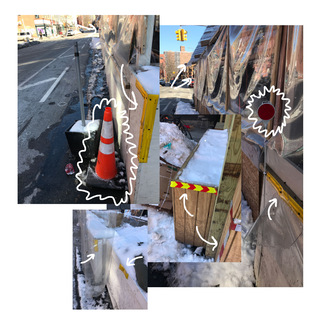Emergent Infrastructures | Lydia Jessup
Since the start of the COVID-19 pandemic almost a year ago, there have been dozens of articles speculating, declaring and analyzing the changes that the built environment of cities has and will undergo. There is historical precedent for these predictions: Bauhaus architecture, for example, was influenced by the 1918 pandemic. This connection clicked for me when I saw a recent photo of scaffolding used to create terraced outdoor dining in Bogota, bauhaus-esque in its functionality, readymade, and asymmetrical design. Today, DIY structures such as these constructed in response to the pandemic are microcosms of new interactions and movements in our public spaces: contactless payment, plexiglass encasements, temperature checkpoints, pneumatic forms demarcating zones of danger or safety, to name a few.
During this micro-residency, I am studying these shifting forms and patterns through the lens of media, sensors and movement and in my current location of Brooklyn, New York City. This research is motivated by the following questions: What new objects, forms and technologies now mediate our public spaces? What design and interaction patterns are emerging? And because of these changes, how are boundaries between public and private shifting and morphing in their permeability, impacting our movements in and in between these spaces?



